By virtue of the gracious edict of Tsar Alexander II, issued on 4 April 1860, Finland had received its own monetary unit, the markka, tied to the Russian rouble, which itself was a fluctuating currency. The name ‘markka’ was defended by the fact that it was the oldest name for money in Finland; originally, it had been used for a medieval unit of weight.
In 1863 Johan Vilhelm Snellman was appointed Chief of Finance of the Senate. In this office, he was responsible for Finland's economic policy, and his key achievement was the pegging of the Finnish markka to the silver standard in 1865, which led to the stabilisation of the country's currency.
The monetary reform, however, did not prove sustainable, as in the 1870s the price of silver started to decline and one state after another changed over to the gold standard: Germany in 1871, Denmark and Sweden in 1873, Norway in 1875 and Finland in 1878. Russia did not adopt the gold standard until 1897.
Redemption of banknotes in gold was suspended in Finland in 1915. In 1926–1931 the gold standard prevailed again until it was abandoned as a consequence of the depression of the early 1930s. Since then, it has not been possible to exchange banknotes for gold.
Historically, Finnish banknotes reflect the country's economic and political history. The shortage of silver at the beginning of the 20th century led to the completion of the banknote series with 1 markka, 25 penni and 50 penni notes. During the national romantic period, the pictorial motifs of banknotes designed by the architect Eliel Saarinen and introduced in 1909 were related to Finnish nature and sources of livelihood, cattle breeding, forestry and shipping. The banknote series of the period of Finnish independence (type 1922) already reflects the features of classicism, and the human figures depicted on the notes ‘inspire confidence in the future’.
|
Historical Finnish banknotes and coins |
|
Designer: Aleksander Fadejev The first markka banknote in Finland (together with the 3 markka note). A temporary payment instrument issued prior to the first coin and proper note series issued in the 1860s. |
|
Designer: Aleksander Fadejev The largest denomination in the first proper note series in Finland. Texts on the obverse are mainly on Swedish, on the reverse in Finnish and Russian. |
|
Designer: Nilaus Fristrup (partially on the basis of themes by the Mint director A F Soldan) Notes, designed and printed in Copenhagen, in use from mid–1870s to end–1880s and limited use early 1890s. The largest denomination was 500 markka, which was introduced when Finland abandoned the silver standard for the gold standard. |
|
Designer: Ferdinand Tilgmann, Friedrich Wanderer The first note printed at the Bank of Finland's own security printing house. The first director of the prin-ting house (until 1909) was a well-known journalist, Mr Ferdinand Tilgmann. He originated from Germany, and he had already been involved in printing the first markka notes in the 1860s. |
|
Printed at: Bradbury, Wilkinson & Co, London (Obverse), and the Bank of Finland Security Printing House (Reverse) The largest denomination of the note series in circulation a century ago. With the advance of note printing techniques, the Bank of Finland became concerned with the security of banknotes. Subsequently the Bank contracted the well-known British firm Bradbury, Wilkinson & Co (in operation in 1824–1984) to print the obverse sides of the notes. The company had the exclusive right to a new printing method developed by the Austrian Musil von Mollenbruch. This method involved special inks and steel engraving, together with special papers. The designer of this series is not known, but the series followed contemporary international style. The reverse sides were printed at the Bank's own printing house. The motifs in this series were details of the monuments to Aleksander II and the national poet Johan Ludvig Runeberg. The 500 markka note features the most famous detail, the figure 'Patria' (also known as 'Lex'). |
|
Designer: Eliel Saarinen The 100 markka note is one of the last note series printed during Finland's autonomy under Russian rule. It was designed by the architect Eliel Saarinen. Stylistically, the series fall to the national romantic Art nouveau school. The two ploughmen on the obverse of the 100 markka note are reminiscent of the grand fresco 'Ilmarinen ploughing the field of snakes' at the Finnish National Museum, painted by Akseli Gal-len-Kallela. The largest denomination in this series was the 1, 000 markka note, which would correspond roughly to FIM 20, 000 today at adjusted time value. This was the first note series featuring Finnish as the main language. In 1918 a version was put into circulation in which all emblems of Russia and texts in Russian were remowed. |
|
Designer: Eliel Saarinen The largest denomination of the first note series after Finland had gained her independence. In general, the series represents the classicism of the 1920s; however, some traces of Art Nouveau still persist. The nude figures caused some controversy when the note was first introduced. The almost spiritual at-mosphere of the 1, 000 markka note, with its train of people bearing a garland on a hazy lake shore to-wards the bright dawn of the newly-independent Finland, is reminiscent of earlier murals in the Tampere cathedral - 'The Procession of the Blessed' (1907) by Magnus Enckell and friezes depicting garland bear-ers (1906) by Hugo Simberg. The note was printed with the text Litt. A in 1929, with the text Litt. C in 1931 and with Litt. D in 1939. In 1946 a new, slightly more reddish issue was introduced (type 1945). Notes with the text Litt. A and Litt. B were in print until 1955. |
|
Designer: Aarne Karjalainen In 1930s a need for a larger denomination note emerged. The planning of a 5, 000 markka note began in 1937, and the model was approved in October 1939. However, owing to preparation for war the need for currency had increased and a provisional issue was deemed necessary. The provisional notes were produ-ced by over-printing the new denomination on an existing stock of 500 markka notes. The regular issue was put into circulation in May 1940. This was the first Finnish note with a portrait of a historical person, Johan Vilhelm Snellman (1806–1881), statesman and philosopher. A new printing technology, rainbow printing was used: the colour changes gradually and smoothly from dark blue to violet. In 1946 a note with the text Litt. A was put into circulation. Its dominant colour was brown and it was in circulation until 1955. |
|
Designer: Tapio Wirkkala This note is one of the last series issued prior to the monetary reform of 1963. The largest denomination in this series was 10,000 markkaa. All Finnish banknotes have been of the same uniform size since this series. Under the monetary reform one current markka equalled a hundred prereform markka. Few changes were introduced to the note types; however, in late 1970s their appearance was altered somewhat. |
|
Designers: Paavo Huovinen and other artists at the Bank of Finland Security Printing House In the 1970s the need for larger denomination notes arose again. The new 500 markka note featured the portrait of the then President of Finland, Urho Kekkonen (1900–1986). The note was put into circulation on his 75th birthday. The obverse features a winter landscape of Vuokatti hill. The reverse features the coat of arms of Finland as well as those of her nine historical provinces. |
|
Designer: Aleksander Fadejev A silver coin struck during Finland's autonomy. In 1865 the markka was fixed to silver – redemption in silver had to be ceased in the 1850s after the Crimean War erupted – and it became an independent cur-rency used along with the rouble. The rouble remained a paper-based currency. Originally, in 1860, the markka/rouble exchange rate was fixed at 4:1. Other denominations in this coin series were 2 markka, 50 penni and 25 penni. |
|
Designer: Aleksander Fadejev A copper coin struck during Finland's autonomy. The other copper coins in this series were 5 and 1 penni. The observe featured monograms of the Grand Dukes of Finland (Alexander II, Alexander III and Nikolai II). After the revolution in March 1917 these coins were struck featuring an uncrowned double-headed eagle of Russia. |
|
Designer: (unknown) Finland adopted gold standard in 1878, joining the international system of gold standard that endured un-til the First Wordl War. In this monetary reform, one Finnish gold markka was given the same value as the French franc. Finland continued to redeem banknotes in gold until 1915. The gold standard was rein-troduced in 1926–1931, and it was abandoned again during the recession in early 1930s. Since then, notes have no longer been redeemed in gold. |
|
Designer: I G Sundell One of the first coin series struck by the newly independent Finland. Although the coin contained 75 per cent copper and only 25 per cent nickel, it was commonly referred to as a nickel markka. At first its di-ameter was 24 mm, ie the same as the one markka coin from Finland's period of autonomy and the one markka coin introduced in the 1960s, but this was later decreased to 21 mm. During the Second World War the one markka coin was made of different alloys and metals, from copper to iron. Other so-called nickel coins in this series were the 50 and 25 penni coins. |
|
Designer: I G Sundell One of the first coin series struck by the newly independent Finland. The smallest denominations (10, 5 and 1 penni) were made of copper. |
|
Designer: I G Sundell The gold standard was reintroduced in 1926–31 (see the above item on the 20 markka coin of 1891). The gold coins of 100 and 200 markka had only a symbolic value and were never used as a means of payment. Furthermore, banknotes no longer had a reference to redemption in gold. |
|
Designer: I G Sundell One of the series of aluminium-bronze coins introduced at the end of the 1920s (20, 10 and 5 markka coins), which replaced low-denomination banknotes for many years. However, a 20 markka note was also in circulation. During and after the Second World War, however, banknotes of corresponding denominations were reintroduced. The 5 markka coin was put into circulation again at the end of the 1940s, and it was made of brass of various alloys. |
|
Designer: P U. Helle One of the last series of coins struck prior to the monetary reforms of 1963. The 50, 20 and 10 markka coins were all made of the same aluminium-bronze alloy, and the 5 and 1 markka coins were of iron. After the reforms, these coins were in circulation until early 1990s, but their real value was only one hundredth of their face value. |
|
Designer: Olof Eriksson, Heikki Häiväoja The design of this coin was the result of an open competition, and was a hybrid of two competing designs. Its diameter was traditional 24 mm, ie the same as that of the one markka coin of the period of autonomy and that of the early years of independence. At first, it was made of silver alloy, but after this became too expensive owing to inflation, it was replaced with cupro-nickel in 1969. A 5 markka coin was introduced in the 1970s in two versions, type 1972 and 1979. These coins in effect replaced the one markka and 5 markka banknotes. |

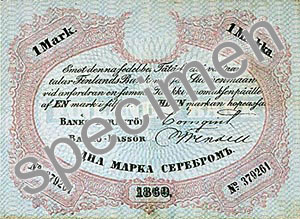 1 markka, type 1860
1 markka, type 1860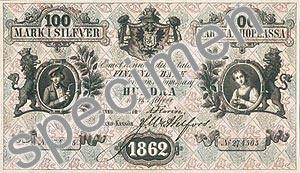 100 markka, 1862 (type 1863)
100 markka, 1862 (type 1863)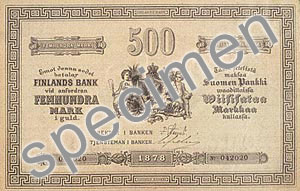 500 markka, 1878 (type 1877)
500 markka, 1878 (type 1877)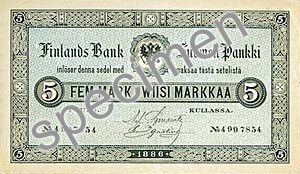 5 markka, 1886
5 markka, 1886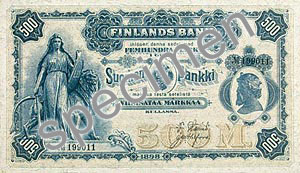 500 markka, 1898
500 markka, 1898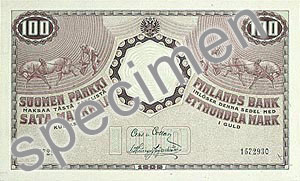 100 markka, type 1909
100 markka, type 1909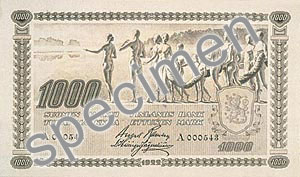 1,000 markka, type 1922
1,000 markka, type 1922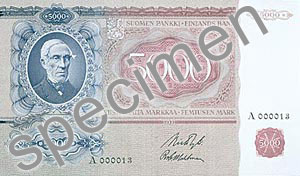 5,000 markka, 1939 (type 1940)
5,000 markka, 1939 (type 1940) 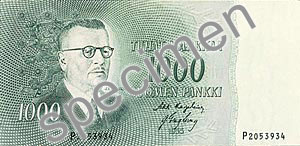 1,000 markka, type 1955
1,000 markka, type 1955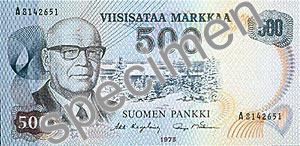 500 markka, type 1975
500 markka, type 1975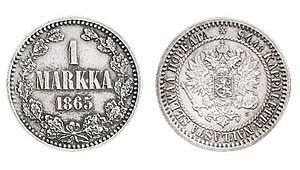 1 markka, 1865 (type 1861)
1 markka, 1865 (type 1861)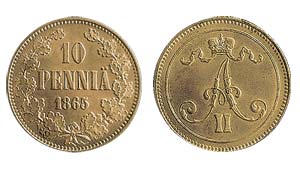 10 penni, 1865 (type 1861)
10 penni, 1865 (type 1861)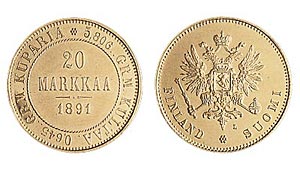 20 markka, 1891 (type 1877)
20 markka, 1891 (type 1877)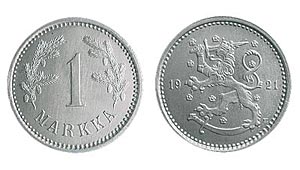 1 markka, 1921 (type 1918)
1 markka, 1921 (type 1918)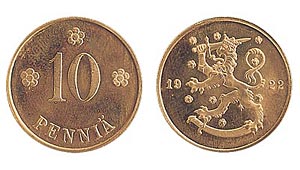 10 penni, 1922 (type 1918)
10 penni, 1922 (type 1918)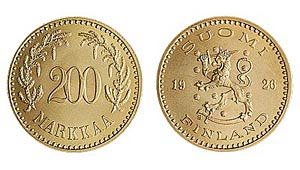 200 markka, type 1926
200 markka, type 1926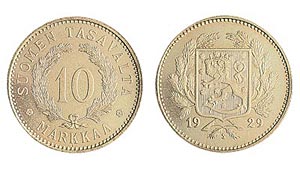 10 markka, 1929 (type 1928)
10 markka, 1929 (type 1928)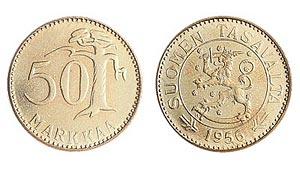 50 markka, 1956 (type 1952)
50 markka, 1956 (type 1952)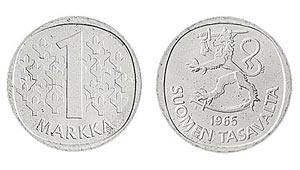 1 markka, 1965 (type 1964)
1 markka, 1965 (type 1964)